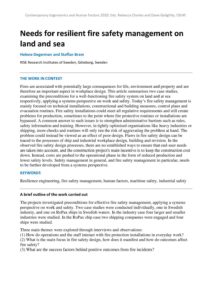| Document | Author Helene Degerman and Staffan Bram |
| Abstract Fires are associated with potentially large consequences for life, environment and property and are therefore an important aspect in workplace design. This article summarises two case studies, examining the preconditions for a well-functioning fire safety system on land and at sea respectively, applying a systems perspective on work and safety. Today’s fire safety management is mainly focused on technical installations, constructional and building measures, control plans and evacuation routines. Fire safety installations could meet all regulative requirements and still create problems for production, sometimes to the point where fire protective routines or installations are bypassed. A common answer to such issues is to strengthen administrative barriers such as rules, safety information and training. However, in tightly optimised organisations like heavy industries or shipping, more checks and routines will only run the risk of aggravating the problem at hand. The problem could instead be viewed as an effect of poor design. Flaws in fire safety design can be traced to the processes of ship and industrial workplace design, building and revision. In the observed fire safety design processes, there are no established ways to ensure that end-user needs are taken into account, and the construction project's main incentive is to keep the construction cost down. Instead, costs are pushed to the operational phase in the form of reduced production and lower safety levels. Safety management in general, and fire safety management in particular, needs to be further developed from a systems perspective. |

